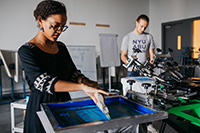-
Academics
-
Admissions
 Your journey to NYUAD starts here. Attend an application workshop or information session.Admissions Events
Your journey to NYUAD starts here. Attend an application workshop or information session.Admissions Events -
Research
-
Campus Life
 Live the possibilities. Be part of a dynamic community of students from over 115 countries.Take a Tour
Live the possibilities. Be part of a dynamic community of students from over 115 countries.Take a Tour - Public Programs
-
About
Exceptional education. World class research. Community-driven.Our Story
- News
- Events
- Social Media Directory
- Press Room
-
- Torch at NYUAD
- Faculty
- Current Students
- Alumni
- عربي
Biofouling Control Strategies to Maintain the Industrial Feasibility and Performance of Filtration Membranes
Biofouling of surfaces in industrial applications increases the operating costs and reduces the process efficiency. The main focus of our research is to understand the interactions controlling the initial binding of bio-foulants to surfaces.
Atomic force microscopy is a valuable technique to assess the biofouling tendency of surfaces, such as water membranes, and to probe the dominant forces that play major roles in the adhesion of bio-foulants.
Biofouling depends on the physico-chemical characteristics to minimize the substrate, bio-foulants, and the intervening medium.
One strategy to govern the biofouling of surfaces is to modify these surfaces and change their characteristics to minimize the dominating forces and increase the repulsion between the membrane surface and the bio-foulants.
The intervening medium characteristics such as ionic strength, pH, and existence of divalent ions can be optimized as well to minimize the adhesion between the surface and the bio-foulants.
